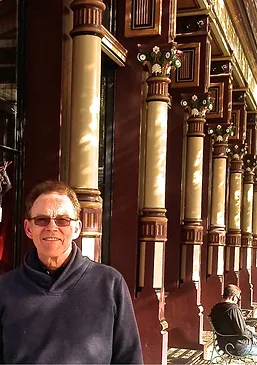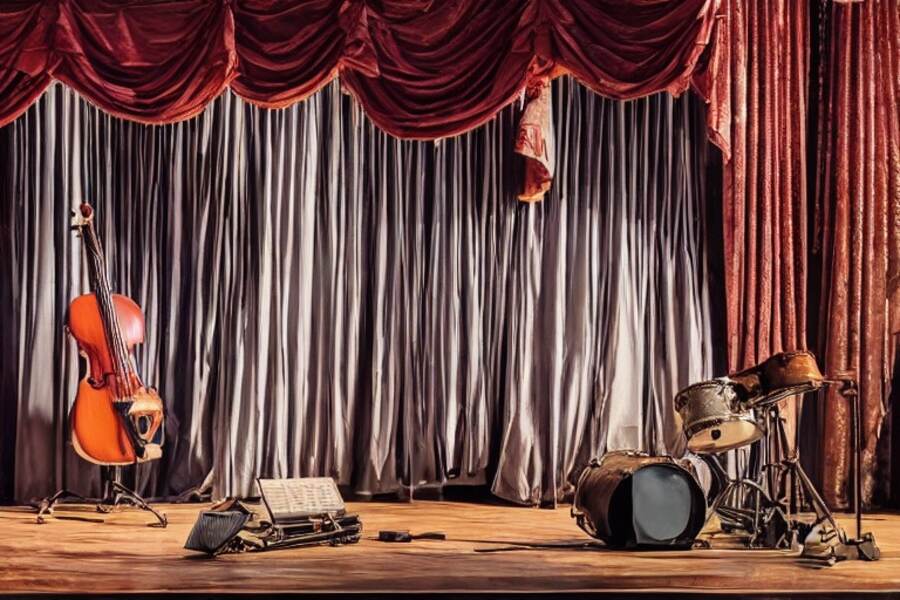Music in theatrical productions can establish setting, pace, subtext, mood, and foreshadowing, and can even cover the noise of set changes. Most importantly, it can shape and guide emotions, deeply engaging the audience. As a composer with over 50 musical scores for theatres ranging from tiny to Tony-winning all across the U.S., I’ve gleaned some practical information from my career to share with other theatre and music artists. Understanding the process and possibilities of incorporating original music in plays creates an opportunity for directors and composers to engage in true artistic collaboration. This is information I wish I had had when I began working in the theatre world as a composer.
A career is built on relationships. As a composer, you should always be making and seeking out new connections with directors and artistic directors, and sharing your credits, reviews, and demos. Let them know you have the compositional and production skills to deliver excellent music. Once you are chosen to work on a production, a contract is negotiated with the theatre. The composer gets a creative fee, and at some larger companies, there may be a production budget to cover the costs of recording, talent fees, and other expenses. The contract should state that the composer alone owns the music and grants the theatre company use of all music created for that production. If the company uses your music for a revival or anything else in the future, a new licensing agreement and fee will be negotiated.
Gather the production schedule, including all production meetings, rehearsals, load-in, tech, previews, and dates of opening and closing. Obtain contact information for the people you will be working with directly: director, production manager, stage manager (SM), soundboard operator (SO), and dance and fight choreographers. Get and read the production script several times. Look for possible musical moments.
Arrange a meeting with your director. Understand the director’s vision and goals for the production. Share your opinions and ideas, but remember, the director gets final say on all decisions. I always ask:
– Time, place, and style of the production?
– In one or two words, what is the emotional essence?
– How much music? Transitions? Underscoring?
– Instrumentation?
– Live or recorded music?
– If live, will music be performed by actors or musicians? Onstage or off?
– Special scenes, crucial turning points, fights, songs or dance?
– Describe characters, themes, and sub-themes.
From this discussion, you can put a plan together and start organizing musical ideas. Schedule a “spotting session” with your director to decide exactly where music will occur and each cue’s function.
At this point, I usually compose, record, and share with the director a four- to six-minute piece of music in the agreed instrumentation with a lot of contrasting sections that cover the moods and tempos discussed. This gives the director a chance to hear your ideas. Usually you’ll find useful and interesting starting points in this music.
Early in the process is the time to ask the stage manager their preference for labeling music cues (numerically or alphabetically). The SM will have a system for calling cues: Lights may be numeric, sound alphabetical. Contact the sound operator as well—this is the person you’ll be working most closely with. Identify delivery format and backup for recorded cues. What’s the house sound? Is it set right for your music? Identify mics, monitors, musician/actor placement used for live performance.
When you have your spotting session with your director, go through the entire play page by page to “spot” the start and end of each musical cue and to establish each one’s feel, function, and rough duration. Make accurate notes. Now you can create a complete list of the cues in order. Include page number, starting and ending line, or action cue.
To prepare for composing, create an instrument and track template in your DAW (Digital Audio Workstation) or musical notation program. Use this for the whole project. It will save you time and fuss. Adapt as needed. Organize and back up your project folders regularly. If you’re recording or performing with musicians, start your talent search and choose your studio (personal or commercial) early. Set dates for rehearsals and recording. If you need to record an orchestra, you may want to use a music contractor who, for a fee, will assemble an orchestra of any size. They will know the players, what to pay, and how to make it all go smoothly.

Every composer has their own process. I don’t compose the cues in order. I start with cues I have definite ideas for. Music is all about feeling. Identify the feeling at the start, middle, and end of each cue. The music should honestly inform and amplify the experience. For dance: Determine mood, tempo, form, and duration with the choreographer, and make practice recordings as early as possible. Watch rehearsals and adjust as needed. Underscored fight scenes can be impactful if you use shifting tempos, time signatures, and textures. Constantly changing music mimics the unpredictability of a fight and can make the underscoring feel natural and alive. I’ve been told by actors that the music actually helps them stay safe. Extend fight cues longer than the scene should last and fade out or add a button (a separate cue, a short definite end to the piece).
Large or outdoor venues require faster tempos, otherwise your music can seem plodding. Make accurate demos for the director using final sounds. Don’t expect anyone to hear what you intend—if you’re thinking krummhorn and lute and share a piano demo, they will only hear piano.
Give the director demos of your work-in-progress with plenty of time to listen to them in advance of your next meeting, where you will discuss the cues written and the direction of your score. Be willing to make changes, cut, or write new cues. Your score must work for the play as the director sees (or hears) it.
If you have actors singing, don’t underestimate the amount of support they’ll need. Give them lead sheets and recordings of the songs with their part mixed prominently. For non-actor live music performers, provide parts and the cue list, complete with in and out line prompts. Rehearse in the space enough for everyone to feel confident. Make sure the director, SM, and SO know the performers’ placement and gear.
Attend enough rehearsals to understand the feel and pace of the show. Adjust accordingly. I often play my cues for myself with earbuds in during rehearsals, watching the actors to check the music’s sound, pacing, feel, and durations.
After the set is loaded in, pay attention to set change durations. They can go longer than expected, creating problems if there’s not enough music. I extend cues so the SM can call a fade. Every performance will be a little different. Between load-in and tech, finalize the recordings of your cues. Master your mixes in a non-compressed format—compression can be problematic in larger spaces. Deliver the show recordings with backups to the SO. Give the director, SM, and SO updated show cue lists. Have the SO play some cues in the theatre and walk the room, listening for hot or dead spots. Make equipment adjustments as needed.
In tech, the composer, director, SM, and SO work closely together setting each cue’s volume levels (fade up, bumps, fade outs) and timings. The composer should take note of any problems and fix or replace them before the next rehearsal.
Attend every remaining rehearsal, preview, and the opening. Pay close attention to sound levels as more people are in the house. Work with the SO to get everything how you want it before opening.
Then let the cast and crew run with it. It’s their show now.
Richard Jennings is the composer of over 20 productions of original musicals, 50-plus scores for plays (including over 30 by Shakespeare).




